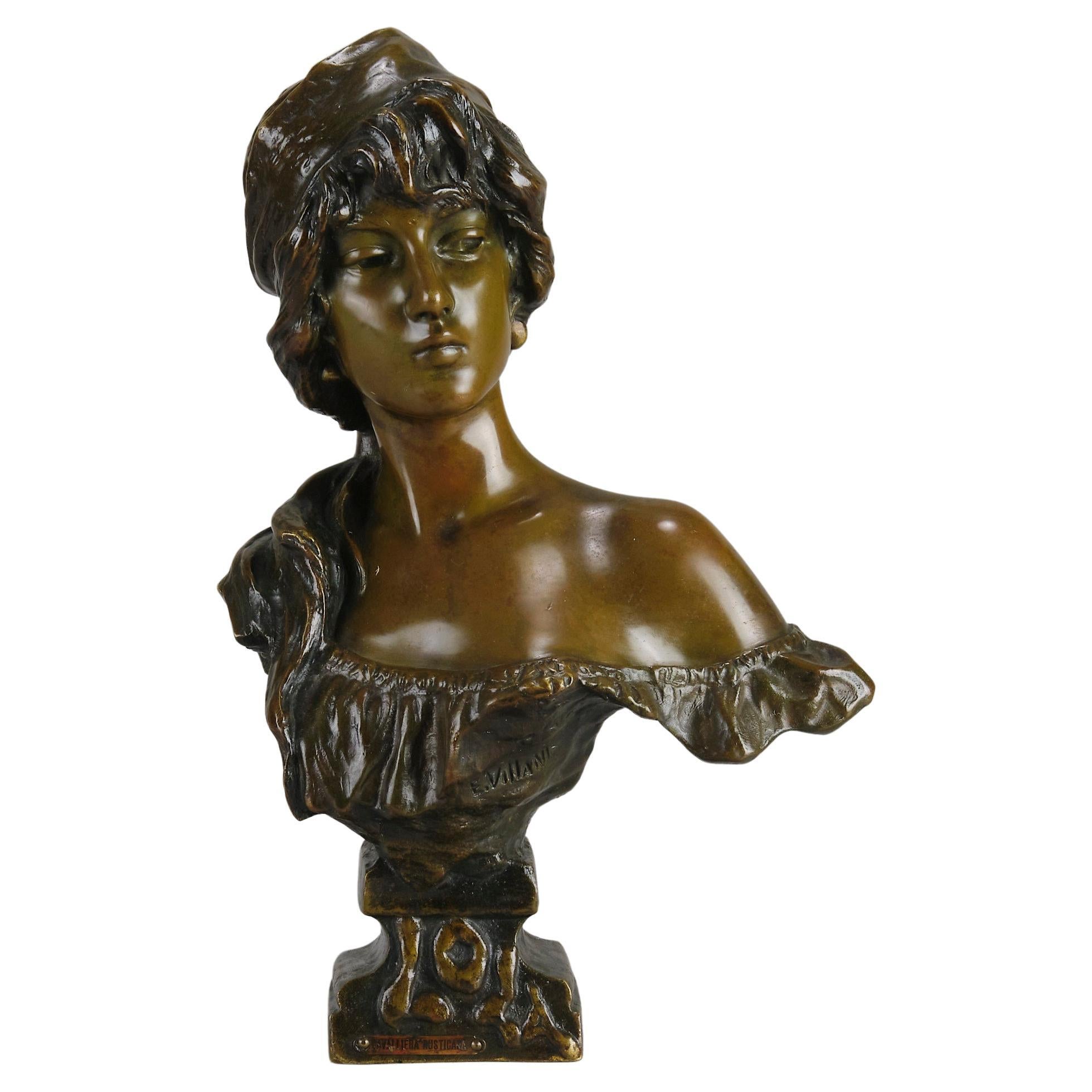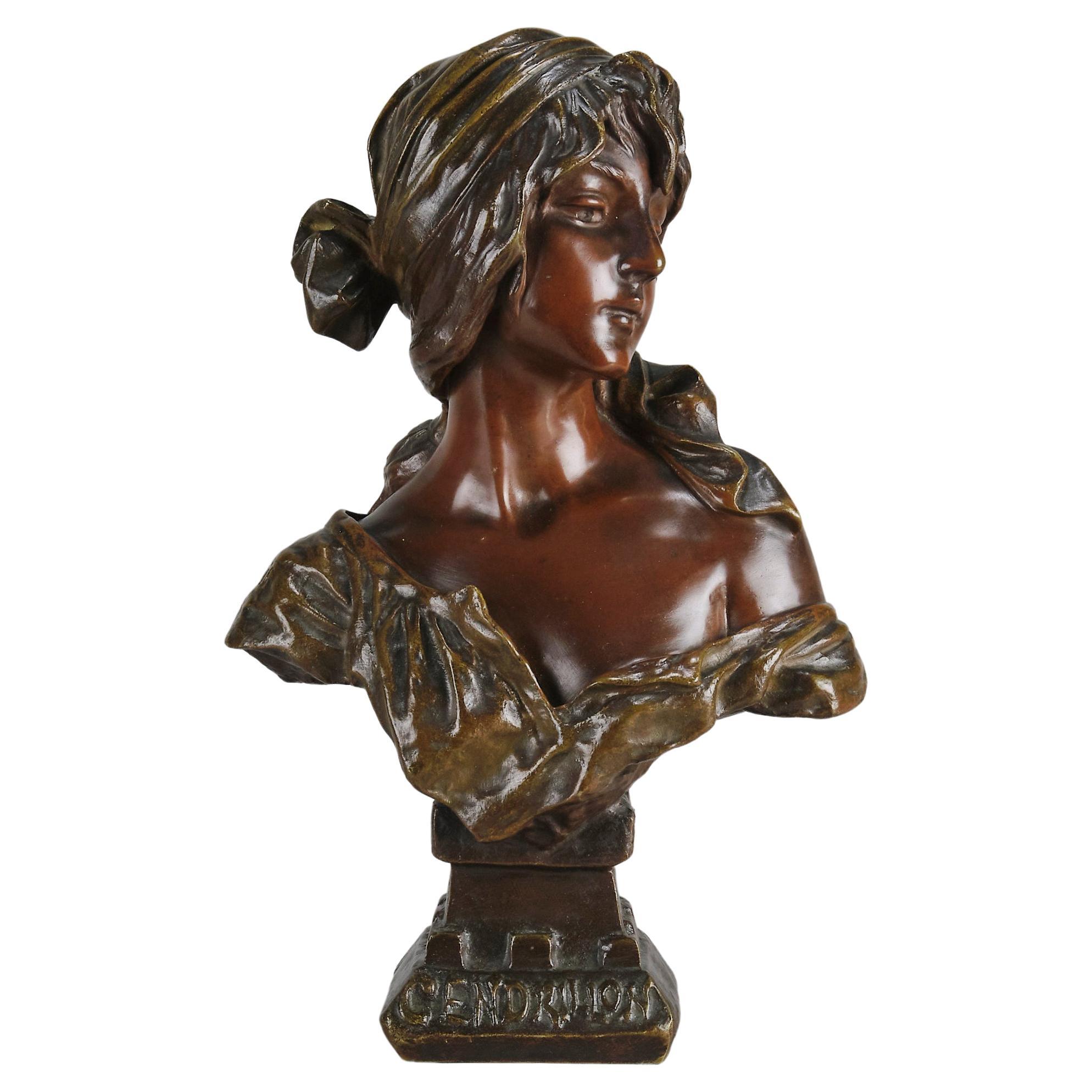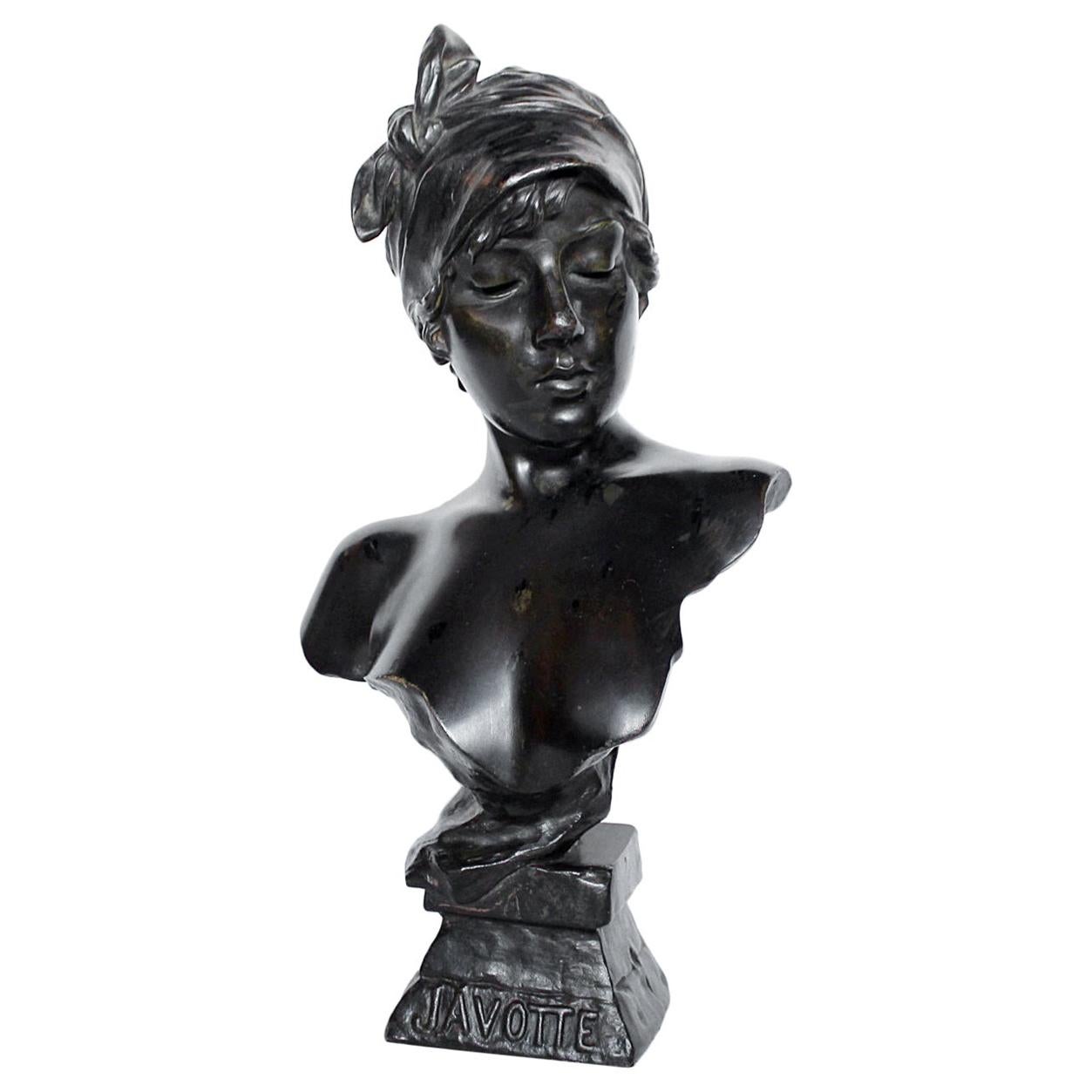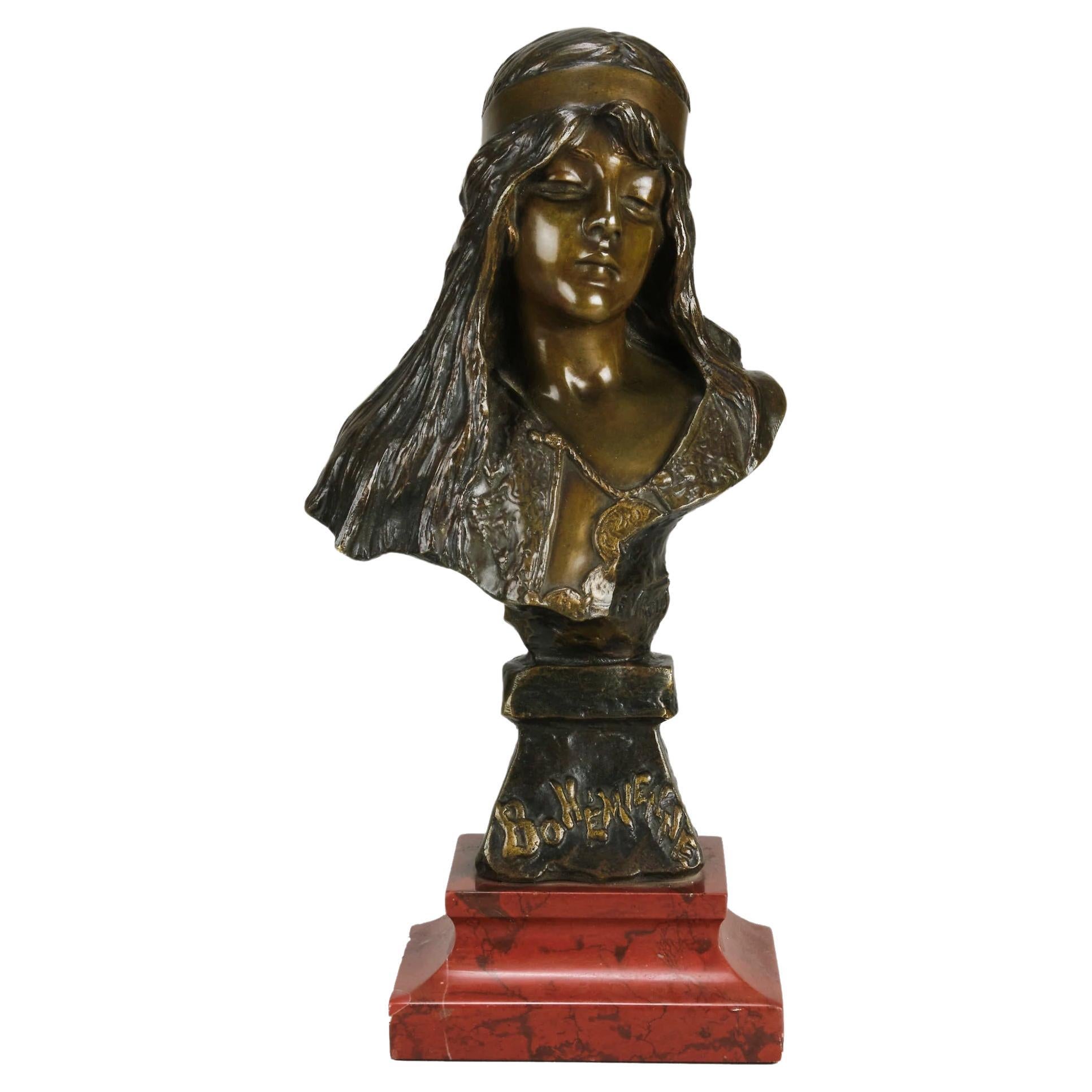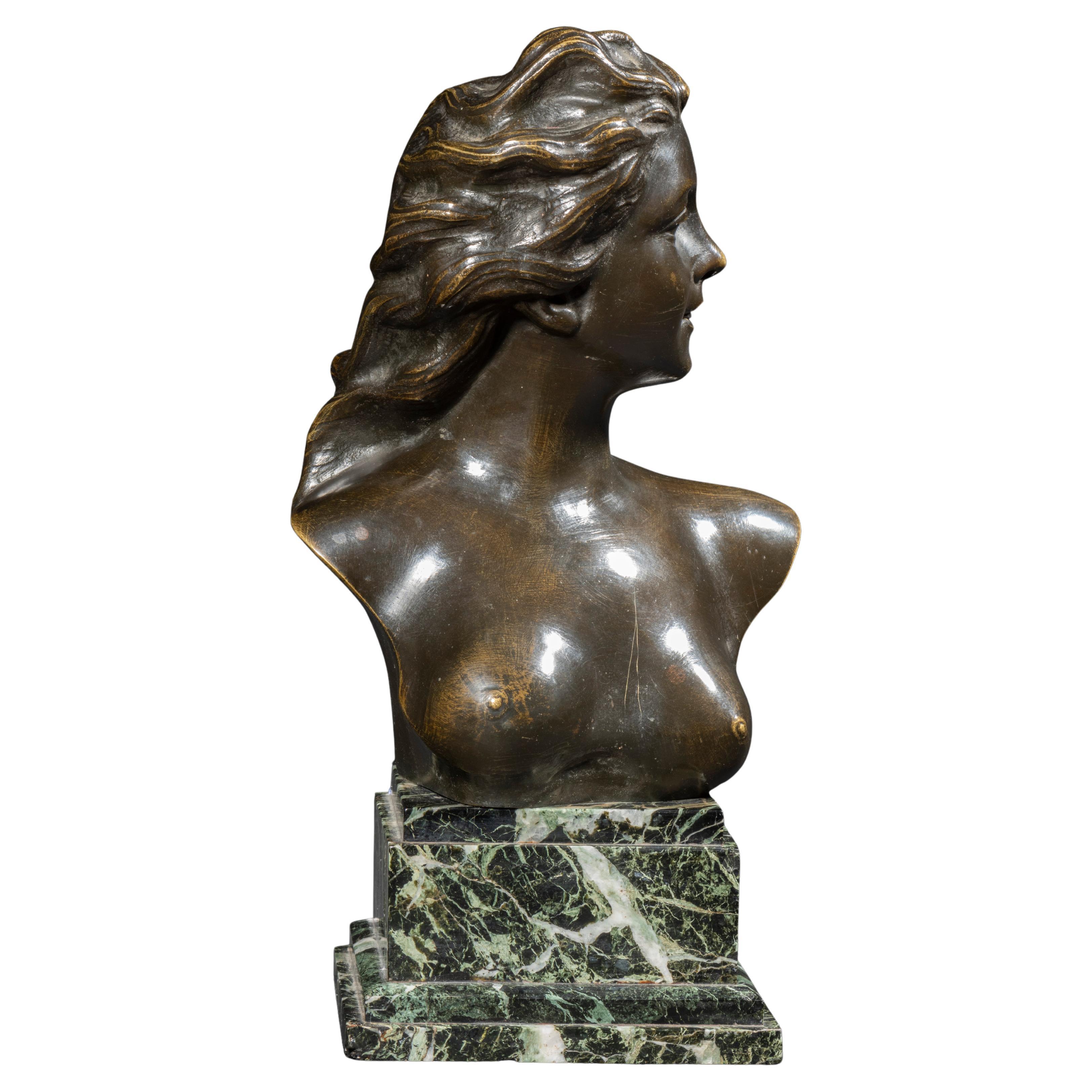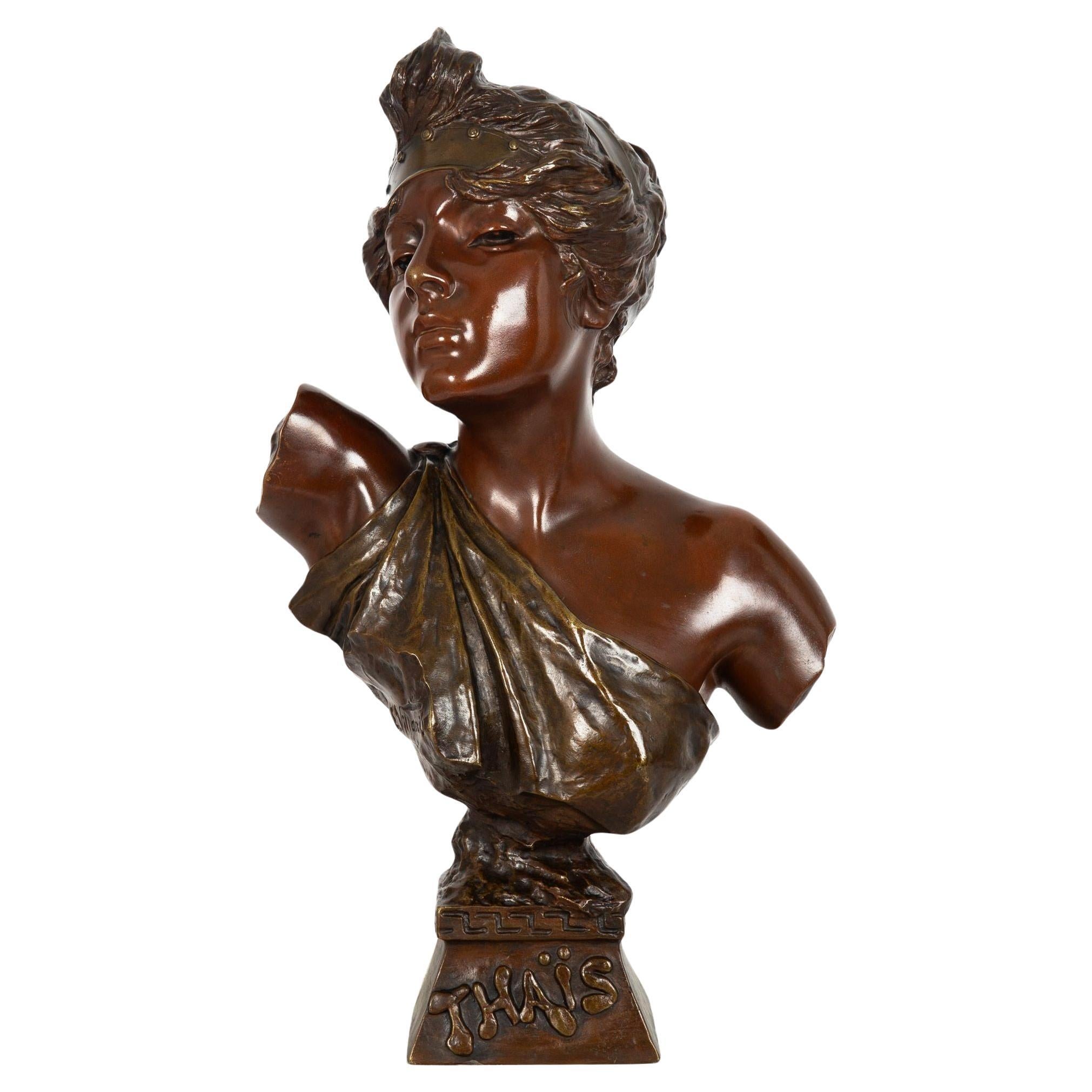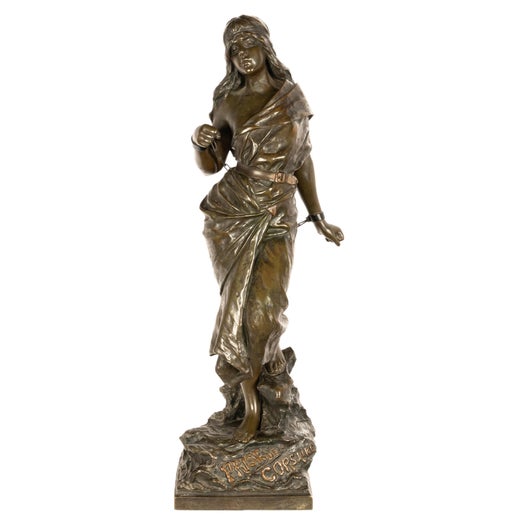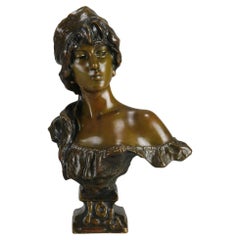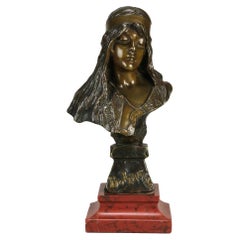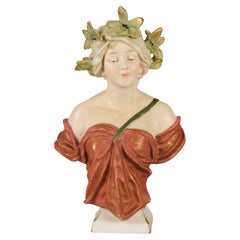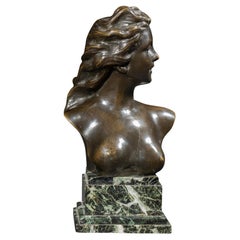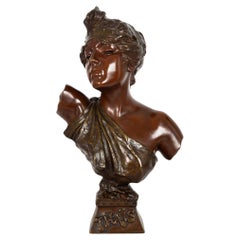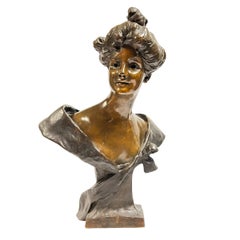Items Similar to Late 19th Century Art Nouveau Bust entitled "Silvia" by Emmanuel Villanis
Want more images or videos?
Request additional images or videos from the seller
1 of 14
Late 19th Century Art Nouveau Bust entitled "Silvia" by Emmanuel Villanis
$4,999.41
£3,650
€4,290.16
CA$6,902.36
A$7,652.29
CHF 4,021.57
MX$93,651.43
NOK 50,225.38
SEK 47,141.54
DKK 32,023.37
About the Item
A very fine late 19th century French bronze bust of an attractive classical maiden modelled in the Art Nouveau style, with fabulous multi hued patination of brown and a subtle green, accentuating the excellent hand finished detail. Signed E Villanis, with Societe des Bronzes foundry seal, numbered and with raised title to the fore.
ADDITIONAL INFORMATION
Height: 28 cm
Width: 16 cm
Depth: 10 cm
Condition: Excellent Original Condition
circa: 1890
Materials: Bronze
Book Ref: Emmanuel Villanis by Josje Hortulanus-de Mik
Page No: 79
SKU: 8775
ABOUT
Sylvia Ballet - Silvia
Sylvia, (the spelling is different in french) is a classical ballet. It features a nondescript mythical setting and a late nineteenth-century score, in which it's themes correlate to giving it a more classical feel, however, it was quite revolutionary for its time. The score was and still is recognized for its greatness. Delibes' work is certainly the best appreciated aspect of the ballet for its innovation, creativity, and maturity. Frederick Ashton's choreography complements the music very well in this respect, staying true to the spirit of the original production while incorporating modern techniques and adding his own unique touch.
The ballet itself follows Sylvia who is a loyal follower of Diana (the goddess of the hunting and chassitity). The story starts with Sylvia being stalked by the diety Eros. When she discovers this they fire their bows at each other respectively. However only Eros's shot is true and wounds Sylvia. This is where she is kidnapped by an unknown assailant later revealed to be Orion.
Sylvia escapes the caves of Orion by getting her captor intoxicated and pleading to Eros to rescue her. When he begrudgingly rescues her he takes her to the temple of Diana where her love awaits. This leads her to repeal her oath of Chassity taken as a follower of Diana.
Emmanuel Villanis
Emmanuel Villanis was an industrious man. He is believed to have created some 200 to 250 pieces. His oeuvre pre-eminently consisted of busts and full body statues. Most of these were manufactured in bronze, but there are also models in white metal and terra cotta. Different patinas were used. The bronzes were mainly cast by the Societé de Bronzes de Paris and can be recognised by the round stamp (cachet) at the back of the statue. In addition, reliefs, vases, lamps, clocks and ink stands are recorded . Vases and lamps were mostly made of tin, and there are also marble statues. Pieces in which ivory is used are as rare as silver statues.
Villanis was inspired by women. He dedicated almost his complete works to them. One model in particular was portrayed many times by him. His portrayals of children may be less known, but are nevertheless wonderfully done. His statues are always in perfect proportion and are full of expression: dreamy-eyed, happy, sirene, indifferent, cheeky, serious, sad, detached, melancholy.
His style can always be recognised by his use of hollowed out eyeballs. The name of the statue can usually be found on the base in scrolled script and the signature of Emmanuel Villanis is always visible and legible.
- Creator:Emmanuel Villanis (Artist)
- Dimensions:Height: 11.03 in (28 cm)Width: 6.3 in (16 cm)Depth: 3.94 in (10 cm)
- Style:Art Nouveau (Of the Period)
- Materials and Techniques:
- Place of Origin:
- Period:
- Date of Manufacture:1890
- Condition:Wear consistent with age and use.
- Seller Location:London, GB
- Reference Number:Seller: 87751stDibs: LU3216333807172
Emmanuel Villanis
Emmanuel Villanis (b. 1858 d. 1914). Originally from Lille, France and of Italian descent, the artist studied in Turin at the Accademia Albertina, under master sculptor Odoardo Tabacchi, before settling in Paris in 1885. A prolific producer of busts during his career, he enjoyed international acclaim for his work. He had a penchant for producing bronzes (particularly busts) of beautiful young women, mainly in the Art Nouveau style. During his lifetime he exhibited widely in Paris, Milan, Chicago, New York and Vienna, his bronzes are both beautiful and highly desirable.
About the Seller
5.0
Vetted Professional Seller
Every seller passes strict standards for authenticity and reliability
Established in 1936
1stDibs seller since 2017
84 sales on 1stDibs
Typical response time: <1 hour
- ShippingRetrieving quote...Shipping from: London, United Kingdom
- Return Policy
Authenticity Guarantee
In the unlikely event there’s an issue with an item’s authenticity, contact us within 1 year for a full refund. DetailsMoney-Back Guarantee
If your item is not as described, is damaged in transit, or does not arrive, contact us within 7 days for a full refund. Details24-Hour Cancellation
You have a 24-hour grace period in which to reconsider your purchase, with no questions asked.Vetted Professional Sellers
Our world-class sellers must adhere to strict standards for service and quality, maintaining the integrity of our listings.Price-Match Guarantee
If you find that a seller listed the same item for a lower price elsewhere, we’ll match it.Trusted Global Delivery
Our best-in-class carrier network provides specialized shipping options worldwide, including custom delivery.More From This Seller
View AllLate 19th Century Art Nouveau Bust Entitled "Lola" by Emmanuel Villanis
By Emmanuel Villanis
Located in London, GB
Stunning Art Nouveau bronze bust depicting the character "Lola" modelled in the midst of an inquisitive look. The study has a multi hued patination of colours that accentuate the very fine hand chased surface detail. Signed ?E Villanis...
Category
Antique 19th Century French Art Nouveau Busts
Materials
Bronze
Late 19th Century Art Nouveau Bust Entitled "Cendrillon" by Emmanuel Villanis
By Emmanuel Villanis
Located in London, GB
An attractive late 19th Century Art Nouveau French bronze bust exhibiting deep multi-hued patination and excellent detail. The beautiful character wearing a head dress and a loosely draped blouse representing ’Cinderella’ from the famous French opera. The bronze is signed E Villanis and titled to the fore on its integral bronze base.
ADDITIONAL INFORMATION
Height: 30 cm
Width: 19 cm
Depth: 12 cm
Condition: excellent original condition
Circa: 1890
Materials: Bronze
Book Ref: Emmanuel Villanis by Josje Hortulanus-de Mik
Page No: 35
SKU: 8773
ABOUT
Villanis Cendrillon
Emmanuel Villanis was an industrious man. He is believed to have created some 200 to 250 pieces. His oeuvre pre-eminently consisted of busts and full body statues...
Category
Antique 19th Century French Art Nouveau Figurative Sculptures
Materials
Bronze
19th Century Art Nouveau Bronze Bust Entitled "Bohémienne" by Emmanuel Villanis
By Emmanuel Villanis
Located in London, GB
Captivating late 19th century French bronze bust of a beautiful woman, enhanced by the variegated rich brown patination and excellent tactile surface detail, raised on an integral bronze base with raised title to the fore. Signed ?E Villanis and further raised on a breche griotte stepped and shaped marble plinth
ADDITIONAL INFORMATION
Height: 33 cm
Width: 16 cm
Depth: 11 cm
Condition: Excellent Original Condition
circa: 1890
Materials: Bronze
Book Ref: Emmanuel Villanis by Josje Hortulanus-de Mik
Page No: 17
SKU: 8616
ABOUT
Puccini's Opera - La Bohème
SYNOPSIS - A group of friends are living a Bohemian life in Paris and trying to make their livings creating art. Rodolfo, the writer, falls in love with the seamstress, Mimi, while Marcello, the painter, and Musetta, the singer, are the on-and-off-again couple by their sides. When the four are happy, they spend their time celebrating life and love. However, Mimi is revealed to be very ill, and Rodolfo struggles to come to terms with the fact that she will inevitably die. Rodolfo and Mimi break up, and months later, Musetta discovers Mimi extremely sick and close to death. She brings Mimi to Rodolfo and Marcello's apartment. Rodolfo immediately takes her in and tries to nurse her back to health, but he is too late. Almost as soon as the two are reunited and have professed their love for one another, Mimi succumbs to her illness and dies.
Emmanuel Villanis
Emmanuel Villanis was an industrious man. He is believed to have created some 200 to 250 pieces. His oeuvre pre-eminently consisted of busts and full body statues. Most of these were manufactured in bronze, but there are also models in white metal and terra cotta. Different patinas were used. The bronzes were mainly cast by the Societé de Bronzes de Paris and can be recognised by the round stamp...
Category
Antique Late 19th Century French Art Nouveau Busts
Materials
Marble, Bronze
Late 19th Century Ceramic Bust entitled "Meditation" by Ernst Wahliss
By Ernst Wahliss
Located in London, GB
A beautiful late 19th Century ceramic Art Nouveau bust in muted vellum tones with gilded highlights modelled as an attractive Art Nouveau maiden wearing a floral headdress with excel...
Category
Antique Late 19th Century Austrian Art Nouveau Busts
Materials
Ceramic
Late 19th Century Art Nouveau Bronze "Nouveau Lady" by Georges Van Der Straeten
By Georges Van der Straeten
Located in London, GB
A delightful Art Nouveau Bronze figure of a young beauty scantily dressed with only a shawl draped across her body in a striking pose. The surface of the bronze with rich golden/brow...
Category
Antique Late 19th Century Belgian Art Nouveau Figurative Sculptures
Materials
Bronze
Late 19th Century Art Nouveau Sculpture "Venus de Milo" by F. Barbedienne
By F. Barbedienne Foundry
Located in London, GB
A large and impressive late 19th Century bronze study of the famous Venus de Milo sculpture of antiquity with excellent rich brown patina and good hand finished surface detail, inscribed F.Barbedienne foundry
ADDITIONAL INFORMATION
Height: 95 cm
Width: 28 cm
Depth: 28 cm
Condition: Excellent Original Condition
Circa: 1890
Materials: Bronze
Foundry: F.Barbedienne
SKU: 7741
ABOUT
The Barbedienne Foundry is a famous 19th century bronze foundry, whose statues and art objects became rapidly very renowned. This bronze studio co-worked with other trades, and put his name to a great variety of works, such as furnishing in particular. Attending every World's Fair of its time, the Barbedienne Foundry was regularly awarded, notably at the World's Fair of 1855 where it was awarded the Great Medal of Honor.
A Parisian bronze maker and caster, Ferdinand Barbedienne (1810-1892) creates a firm in 1839 in collaboration with Achille Collas, the inventor of the mechanical method to obtain copies of sculptures at a smaller scale. With this groundbreaking proceed, they facilitated an unprecedented production. Under the “Collas et Barbedienne” name, they specialized in Antiquity copies and perfected new chemical methods for the color and patina finish of their bronzes. As a true Romantic, Ferdinand Barbedienne is committed to democratization of arts, he thus realizes numerous Antiquity copies and stimulates his contemporaries’ works broadcasting. A great deal of famous sculptures are hence cast by the Barbedienne Foundry. All his life, Barbedienne co-worked with the greatest artists, sculptors or designers of his time, such as Edouard Lievre, Ferdinand Levillain, Attarge, Aizelin, Barye or Fremiet.
Statues aside, he products a great deal of decorative artifacts, such as clocks, vases, mirrors, etc. Since 1855, Ferdinand Barbedienne collaborates with the famous decoration designer Louis-Constant Sévin (1821-1888). Joining the firm as a sculptor-designer, he stays loyal to it his life long, always finding more new designs for daily objects, which hence become true art works. Sevin’s creations, specialized in the “Neo-Greek” style, were particularly appreciated for antiquity reference in decorative arts, just like the great mirror preserved by the Orsay Museum. He also teams up with enamelers including Alfred Serre, and develops a set of “cloisonnés” enamels that made the headlines at the World's Fair of 1862 in London, which was the very beginning of the art of enamel’s return. In collaboration with Serre, Barbedienne realized between 1878 and 1889 the Monumental Clock in Renaissance style, decorated with enamels, which is preserved in the Paris City Hall.
Venus de Milo
Facts about Venus de Milo sculpture.
For much of the world, the mystery of the Venus de Milo lies in her missing arms. But there’s much more to this iconic statue than a couple of absent appendages.
1. Venus de Milo‘s title is a bit misleading.
It’s popularly believed that this Grecian statue depicts the Greek Goddess of love and beauty, who was often rendered half-naked. However, the Greeks would have called this deity Aphrodite. Nonetheless, the Roman-inspired Venus de Milo caught on.
2. She’s named in part for where she was discovered.
On April 8, 1820, a farmer named Yorgos Kentrotas came across the statue in pieces within the ruins of an ancient city on the island of Milos (formerly known as Melos).
3. Alexandros of Antioch is credited with her creation.
A sculptor of the Hellenistic period, Alexandros is believed to have carved this masterpiece between 130 and 100 BCE. The inscription on the plinth—the slab on which the statue rested—that identified him as Venus de Milo‘s creator was lost nearly 200 years ago.
4. She might not be Venus.
Some have suggested the sculpture is not Aphrodite/Venus, but Amphitrite, the sea goddess who was particularly adored on Milos. Still others have proposed she’s Victory, or perhaps a prostitute. With her arms long missing, would-be context clues have been lost for centuries. A spear could have meant one thing, a spool of thread another. If she held an apple—as some reports claim—it could mean she was Aphrodite, holding the award given to her by Paris before the Trojan War began. To this day, it’s a matter of passionate debate.
5. She became a gift to the King of France.
When Kentrotas called upon a French naval officer to help him unearth the spectacular sculpture, he began a chain of events that would eventually lead to the Marquis de Rivière presenting Venus de Milo to Louis XVIII. In turn, the ruler gave the statue to the Louvre, where it is on display to this very day.
6. The loss of her limbs is the fault of the French.
Kentrotas did find fragments of an arm and a hand when he uncovered the statue in the ruins, but as Venus de Milo was being reassembled, those arms were discarded for having a “rougher” appearance. Modern art historians believe that the variation of finish does not mean those arms did not belong to Venus, but both the arms and the original plinth have been lost since the piece moved to Paris in 1820.
7. The original plinth was ditched on purpose.
Sight unseen, early 19th century art historians decided the newly discovered Venus must have been the work of Greek artist Praxiteles, and publicized the work as such. This attribution would have placed the piece in the Classical period (5th through 4th centuries BCE), which was more respected artistically than the Hellenistic period. To save face and better promote Venus de Milo—even at the cost of misinforming the public—the plinth was removed before it was presented to the King.
8. Venus de Milo was meant to make up for a national embarrassment.
During his conquests, Napoleon Bonaparte had plundered one of the finest examples of Greek sculpture, Venus de’ Medici, from Italy. In 1815, the French government returned that beloved sculpture, but in 1820, France embraced the chance to fill the hole its absence left in the French culture and national pride. As such, Venus de Milo was promoted as being even greater than Venus de’ Medici upon her Louvre debut. The ploy worked, and the piece was met with almost universal praise from artists and critics.
9. Renoir was not impressed.
Perhaps the most famous of Venus de Milo‘s detractors, the celebrated Impressionist painter dismissed this delicate depiction of grace and female beauty as “a big gendarme.”
10. She went into hiding during World War II.
By the autumn of 1939, war threatened to descend on Paris, so Venus de Milo along with some other priceless pieces, such as Winged Victory of Samothrace and Michelangelo’s Slaves, were whisked away for safekeeping at various châteaux in the French countryside.
11. She’s been robbed!
Venus is missing more than just her arms. She was originally draped in jewellery including a bracelet, earrings and a headband. These flourishes are long lost, but the holes for fixing them to the piece remain in the marble, giving clues to the missing accessories.
12. She lost her colour.
While it’s easy for today’s art admirers to think of Greek statues as white, the marble was often painted in the style of polychromy. However, no trace of the original paint scheme remains on Venus de Milo today.
13. She’s taller than most people.
Even with her slight slouch, Venus de Milo stands at 6 feet 8 inches tall.
14. She could be a copy.
Art historians have noted that Venus de Milo bears a striking resemblance to Aphrodite of Capua, which is a Roman era copy of a possibly late 4th century BCE bronze Greek original. That would be at least 170 years before Alexandros carved his goddess, leading some to speculate that both statues are actually replicas of an older statue...
Category
Antique Late 19th Century French Art Nouveau Figurative Sculptures
Materials
Bronze
You May Also Like
'Janotte' Emmanuel Villanis Art Nouveau Bronze Bust, French, 1890
By Emmanuel Villanis
Located in Forest Row, East Sussex
Janotte, an Art Nouveau, patinated bronze bust of a young lady with head scarf. Dark brown patination. Set on an integral plinth. Signed Villanis under shoulder.
Signed Villanis u...
Category
Antique Late 19th Century French Art Nouveau Busts
Materials
Bronze
$4,520 Sale Price
25% Off
JEF LAMBEAUX (1852-1908) "Bust of a Young Woman" in bronze
By Jef Lambeaux
Located in Ixelles, BE
JEF LAMBEAUX (1852-1908) "Bust of a Young Woman" in bronze.
Jef Lambeaux's "Bust of a Young Woman" with bared breasts is a striking work of art that embodies both beauty and controversy. Created by the eminent Belgian sculptor Jef Lambeaux (1852-1908), this bronze sculpture reveals exceptional technical mastery and extraordinary artistic sensitivity. The young woman depicted, with her hair flowing freely and her face imbued with serenity, embodies the quintessence of feminine beauty.
This work is part of the Romantic Realism...
Category
Antique Late 19th Century Belgian Art Nouveau Busts
Materials
Bronze
French Art Nouveau Bronze Sculpture “Bust of Thais” by Emmanuel Villanis
By Emmanuel Villanis
Located in Shippensburg, PA
EMMANUEL VILLANIS
French, fl. 1880-1920
"Bust of Thais"
Cast signature to shoulder "E. Villanis" cold-stamped "3264" & "CB" with foundry cachet of "Societe des Bronzes de Paris" o...
Category
20th Century French Art Nouveau Busts
Materials
Bronze
Art Nouveau Bronze Female Bust by George van der Straeten (1856-1928)
By Georges Van der Straeten
Located in New York, NY
Large Art Nouveau period patinated bronze bust of a lovely female by George van der Straeten (1856-1928).
Category
Antique Late 19th Century French Belle Époque Figurative Sculptures
Materials
Bronze
Julien Caussé, Art Nouveau Bronze Bust of a Young Beauty, France, circa 1900
By Julien Causse
Located in København, Copenhagen
Julien Caussé, a well listed French sculptor.
Art Nouveau bronze bust of a young beauty "Cigale".
In very good condition, fine patina.
France, circa 1900.
Stamp: J. Caus...
Category
Antique Early 1900s French Art Nouveau Busts
$1,280 Sale Price
20% Off
Bronze bust of a Bohemian young girl, 1920
Located in Brighton, Sussex
Enchanting patinated bronze bust of a young Bohemian girl.
Batch 81 G340/24 DNYZ
Category
Early 20th Century French Art Nouveau Abstract Sculptures
Materials
Bronze
More Ways To Browse
Rare Bust
Antique Silver Statue
Classical Relief Sculpture
Art Nouveau Green Lamp
Tin Man
Children Statue
Art Nouveau Maiden
Art Nouveau Seal
Antique Statue Lamps
Metal Book Stands
Bronze Sculpture Diana
Marble Statue Modern
Art Nouveau Bronze Statue
19th Century Bronze Goddess Sculpture
French Art Nouveau Bronze Busts
Lamps With Bust
Terra Cotta Bust
Art Nouveau Marble Bust
